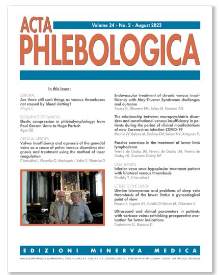The relationship between neuropsychiatric disorders and constitutional venous insufficiency in patients during the period of clinical manifestations of new Coronavirus infection COVID-19

Victor V. MASHIN, Lyudmila A. BELOVA, Evgeny M. DUDIKOV, Natalia V. BELOVA, Pier L. ANTIGNANI
Acta Phlebologica 2023 August;24(2):68-71
BACKGROUND: The purpose of the study was to evaluate the relationship between neuropsychiatric disorders and the presence or absence of constitutional venous insufficiency (CVI) in patients during the period of clinical manifestations of a new coronavirus infection COVID-19.Acta Phlebologica 2023 August;24(2):68-71
METHODS: The analysis of the survey results of 42 patients in the period of clinical manifestations of a new coronavirus infection COVID-19 has been given. The median age of all patients was 63.5 (56.8; 69.0) years. The diagnosis of COVID-19 was confirmed with instrumental (computed tomography/chest X-ray) and laboratory methods (PCR - test for the presence of SARS-CoV-2 coronavirus RNA). To assess the neuropsychic status, screening testing of cognitive functions (MOCA Test), an assessment of the degree of anxiety and depression (HADS), as well as an assessment of night sleep disorders (night sleep assessment questionnaire) were carried out.
RESULTS: There were no statistically significant differences between patients with and without CVI during the period of clinical manifestations of COVID-19 in the severity of cognitive impairment (P>0.05). Patients in the period of clinical manifestations of COVID-19 with the presence of CVI had a higher degree of anxiety than patients without the CVI syndrome (P<0.01).
CONCLUSIONS: There were no statistically significant differences in the degree of depression between patients with and without CVI during the period of clinical manifestations of COVID-19 (P>0.05). Patients in the period of clinical manifestations of a new coronavirus infection COVID-19 with the CVI syndrome had clinically significant insomnia, while patients in the period of clinical manifestations of a new coronavirus infection COVID-19 without the CVI syndrome had subclinical night sleep disturbances. There were no significant differences in the degree of night sleep disturbances between groups of patients with and without CVI during the period of clinical manifestations of COVID-19 (P>0.05).
Дата издания: 21.08.2023